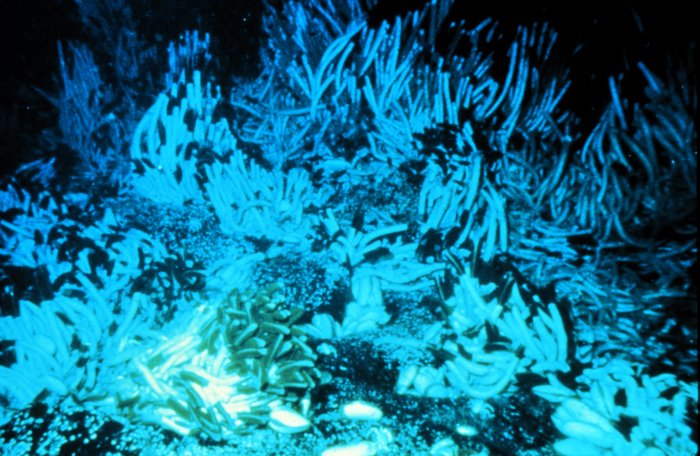
Tube worm colony Photo Courtesy of the NOAA
Tube worms are one of the most amazing animals that inhabit this planet. They posses no digestive system, yet they themselves are not a chemoautotroph. So how do they survive?

Tube worm colony Photo Courtesy of the NOAA
Tube worms host chemosynthetic bacteria inside their bodies and use the products produced by these organisms to survive. The symbiotic relationship between the microbes and the tube worm is beneifical for both organisms the bacteria is safe from predators and is provided with food by the tube worm circulation system. The tube worm does not have to eat microbes instead it just has to absorb the readily available oxygen, carbon dioxide and hydrogen sulphide, which the microbes then convert to organic compounds for it to use.
The circulation system of a tube worm has the difficult task of providing the microbes with food. The oxidation of hydrogen sulphide is violent so tube worms have adapted their hemoglobins to transport oxygen, carbon dioxide and hydrogen sulphide so that no reaction occurs. The chemicals are then used by the bacteria to in the trophosome.
The chemicals are absorbed by the plume of a worm and then transported through the vestimentum to the trophosome where the microbes live inside the worm. There are an estimated 285 billion microbes per ounce trophosomic tissue. The waste products from the reaction are then stored inside the animal. Having no digestive system the tube worm has no need for an anus.
Tube worms live in a shell like tube that they produce hence the name tube worm. The tube protects them from any predators in the area they simply withdraw their plume into the tube much like a turtle withdraw as itís head into itís shell. The new tube is produced by two parts of the worm one at the bottom of the tube where the worm attaches it self to the ocean floor and the other at the top of the tube. These parts of the worm are called the opisthosome and vestimentum respectively.
Sources: P. Tyson